

| Cruisers> > Hampton Safari |
| For more information about Hampton Boats & Safaris, please see my Hampton Boats History page. | |
|
Our current boat
is a 1975 Hampton Safari. I've refitted the boat and made a number of modifications as illustrated on this web page. |
|
|
During the refit in 2002, I repainted her in the more reserved colour sheme shown here. I used marine paint throughout, so it was quite an expensive business. About 4 litres of International PreKote & Toplac and 2½ litres of 'Blakes Broads' antifouling came to a tidy three figure sum. |
|
| During the pre-purchase survey (by Gary Holmes), the moisture levels were within reasonable limits, and there were only a few (quite small) osmosis blisters.The boat had been re-engined by the previous owners in 1989 with a Yanmar 2GM20F 18hp twin cylinder diesel, so the prop shown here was a 14" x 9" pitch replacement. (The original BMC or Perkins engine would have been between 30 and 45 hp, so would have presumably had a larger pitch prop.) |
|
| During the refit, the underneath of the hull was re-coated with 3 coats of 'Black Tar Varnish' with a band of Blakes 'Broads' antifouling up to the waterline. Many of the hire boats and ex-hire boats use tar varnish as the antifoul and it appears to stand up well to the broads environment (without being noxious when dried), staying clear of slime and protecting the fibreglass. ( and maybe also it's popular because it's about £12 per 5 litres as against anti-fouling which costs around 8 times as much !) |
|
|
The refit suffered a major setback when rot was discovered in the wooden lining of the sliding canopy. Luckily, the main structure was a hefty lay-up of fibreglass, and the rot was eradicated by lifting the canopy from the boat and relining each side with a single piece of 18mm WBP bedded and coated with epoxy resin. (even without the windows and lining, the canopy still needed a crane to lower it to the ground !) |
 |
|
Much of the refit
was carried out by myself at The Martham Boat Building & Development
Company, at Martham, Norfolk. They provide excellent facilities for
DIY owners at reasonable prices. Although their (enormous) covered workshop
is about a mile from the River Thurne, their lift out and
re-launch costs include the transportation on their own trailer. Their
professional boatbuilders were also very friendly and helpful with expert
advice (when asked for). |
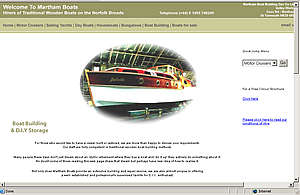 |
|
Here she is being brought back to the slipway for the grand re-launch in September 2002, eight weeks after she was taken out. (I had estimated that the work would take about three weeks, but they tell me that DIY owners are always optimistic in that respect.......) |
|
|
I've looked in quite a few Hampton Safaris, and as with many of the older hire boats, they are usually lined with colourful formica. Fine for keeping clean and standing up to hirer's use, but very clinical looking. Luckily, ours already had large areas of varnished paneling, which gives a much warmer impression. During the refit I replaced the wheel and some of the controls and mounted the helm seat on a swiveling, extending pedestal (instead of the fixed cupboard). Also visible in this photo is the new floor covering of heavy duty (water resistant) carpet tiles, with 'D' section alluminium strips covering the removable panel joints.(All areas of the bilge are now independently accessible). The control panel for the Yanmar had no gauges, and I like to know how the engine's doing a bit more than warning lights, so I fitted a set of Faria gauges (oil press, water temp, rev counter/hour gauge and voltmeter). I had the ammeter made up with a 200 amp shunt, by the helpful people at Adverc Ltd., to avoid running the main feed up to the dashboard. |
|
|
Although the engine
had already been replaced, I made a number of alterations to the installation. |
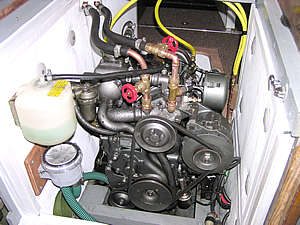 |
|
The exhaust system was replaced with a Quietlife fibreglass water-trap/silencer and Vetus convoluted hose. With the soundproofing,
the engine was now much quieter, but there was still a lot of noise and
vibration when under way, (especially at higher revs.). |
|
|
I linked the sliding wheelhouse to the boat with coiled lead from a caravan accessory shop to power the lighting. It gives a range of movement of about 6 feet, and automatically coils back. The seven cores enable internal, running and anchor lights and are of sufficient gauge for the current required. Also visible are the Chubb (patio door) deadlocks which supplement the front catches to make sure that the cabin roof is firmly locked when closed. |
 |
|
I like the advantages of the forward control layout, but I did miss the aft cockpit when fishing. To compensate for this, I fitted a slatted seat and had a stainless steel pushpit made by MarineWeld of North Walsham. It really adds to the usability of the boat and makes getting on and off via the stern much safer. It is splayed outwards to give the maximum walk around space without protruding past the fender rail. Also visible is the new mahogany rear door which I made to replace the original twin plywood doors. The window was obtained (secondhand) from Tony Burford at Brundall. |
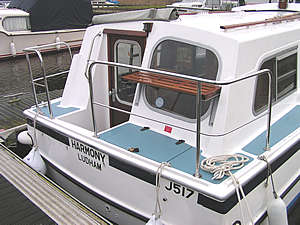 |
|
In order to pass the Boat Safety Certificate Examination (also by Gary Holmes), one of the requirements was that the fuel tank (and all of it's connections) could be examined by the inspector. Unfortunately, when the boat was built back in 1975, this scenario could not have been forseen, and the big 50 gallon tank, fitted under the port side deck, was completely closed in by the plywood back of the galley unit. I had to dismantle the whole thing and rebuild it in such a way that the back could removed in-situ for future inspections. Also, as this was the only furniture in the boat to be made out of chipboard (arrrghh....) I took the opportunity to use the old parts as templates to cut new panels from marine ply. The cooker area was lined completely with stainless steel and a venetion blind was fitted in place of the curtain. Not very 'boaty' but very practical. |
|
|
The tankage in hire cruisers tends to be on the generous side. She originally carried 50 gallons of diesel, 2 x 40 gallons of fresh water and had a 25 gallon waste holding tank. The waste and water tanks completely filled the space beneath the rear double bed. I found that we could get e better 'turnover' with 40 gallons of water, so I removed the other 40 gallon tank. I was then able to shift them both over to the side of the boat (to balance the 50 gallon diesel tank on the other side). I then lagged the water tank and then built an additional longitudinal partition under the bed to create a new 2 m long 600mm wide 450mm deep locker. I also changed the green heliflex hoses for the proper double wall (white) 'stink free' hoses at the same time. (Even with this reduced storage, we still keep our drinking water in 2 gallon jerricans which we can refresh on an almost daily basis.) |
|
|
This picture (on the River Thurne) shows:
|
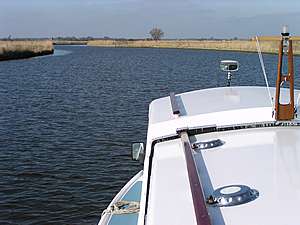 |
|
This photo, taken at Womack Water, shows the foredeck with the small manual anchor winch that I got from one of the Horning boat auctions. It's great for breaking the considerable suction when raising the mudweight. Also just visible in the gloom above the windows are the spring loaded roller blinds that make driving toward the sun much more comfortable, as they act as infinitely adjustable sun visors to th very large front windows. (They're made out of blackout material). |
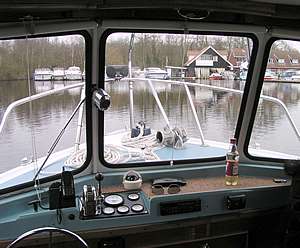 |
| The
latest mod is my new 'handbrake'. High sided broads cruisers can be difficult
to steer in side winds, as the front windage is high (due to the wheelhouse)
and the front underwater 'grip' is low (due to the keel tapering off at
the front.) This means that the boat always turns away from the wind, whenever it has no steerage way. To counteract this, and enable easier stern-on reversing, I added an electric vehicle winch (from MachineMart), controlling a second mudweight over a stem-head roller. It can now be lowered or raised from a rocker switch at the helm postion (inside) in about 7 seconds. I chose a vehicle winch because the mudweight rope stays on the drum, whereas all boat winches use capstans, (for either chain or rope) that need to be either hand led, and/or fed into a chain locker. The drum is a little small, designed for 5mm wire, but you can just get 5 metres of 10mm terylene on them. (I didn't leave the wire rope on as I don't like the idea of being tethered to the bottom by something I can't cut quickly with a knife !) The rope is colour coded to show how much rope is ranged out at any time (you only need a scope of about 1½ - 1 with a mudweight). |
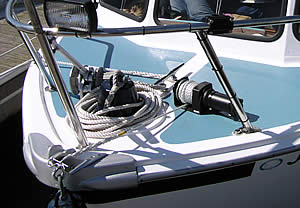 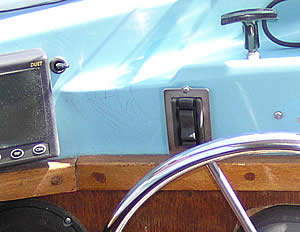 |
|
Links & References to Suppliers ASAP Supplies of Beccles - Quietlife silencer, Faria gauges, Vetus products Martham Boat Building & Development Co. Ltd. - DIY refit facilities at Martham Adverc Battery Management - Modification and supply of 200 amp shunted ammeter MarineWeld of North Walsham 01692 404018 - Made to Order Stainless Steel Pushpit Tony Burford Marine Windows 01603 714597 - Supply of s/hand window for new rear door Norfolk Marine (Chandlers) Wroxham 01603 783150 - Barrow loads of fittings, paint etc. ! Walker Rubber & Plastics Ltd - Window rubbers & large bore hoses etc. Wilks (Rubber Plastics) Co Ltd - two part D fender Tim Collin (Wroxham) 01603 783788 - Hardwoods & Marine Ply Cinque Ports Marine Services - Pre-purchase survey and Boat Safety Scheme Certificate |
|
(all of the
images on this page were taken with an Olympus C730 digital camera)
(they have been significantly downsized and optimised for fast loading over
the web)
©2004 Shorebase